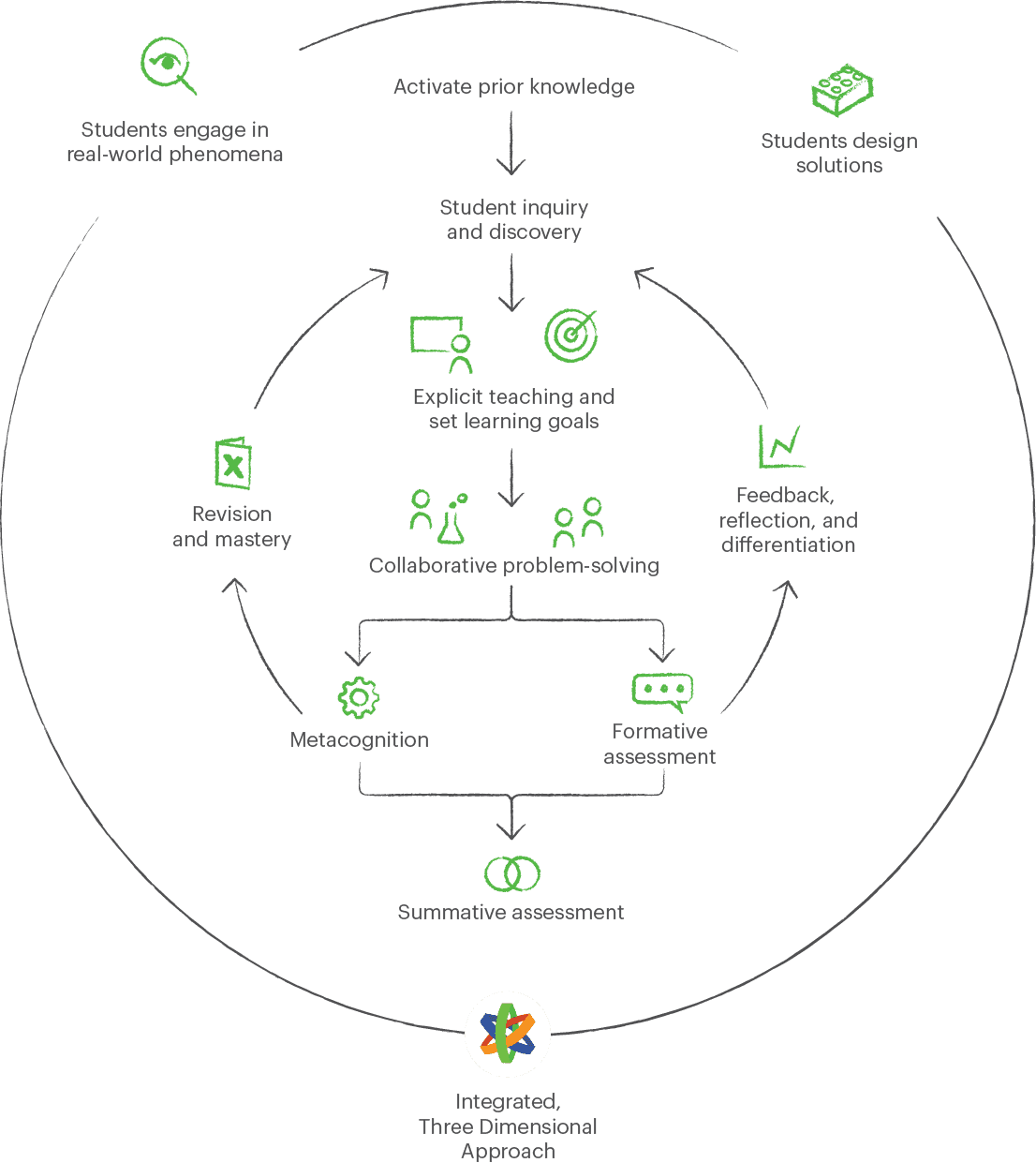Evidence-based pedagogy
Stile helps teachers implement evidence-based teaching strategies

Stile’s learning resources, technology and professional learning offerings have been crafted to make it easy to teach the Next Generation Science Standards (NGSS). We draw on phenomenon-based, student-driven, three-dimensional approaches to science education.
Pedagogy for the classroom
Stile’s classroom resources are built to support pedagogies where teachers are highly involved in crafting and directing the learning experience. The pedagogical flow typically looks like this:

Stile is the ultimate Curriculum to encourage evidence-based teaching strategies
Learn more about the proven strategies that underpin everything we do!
Students engage in real-world phenomena
Every Stile unit is centered around an intriguing phenomenon, intentionally selected to motivate curiosity. Upon their introduction to the anchoring phenomenon, students are driven to ask questions and seek answers that explain it.
Students design solutions
Stile’s lessons draw direct links between real-world technologies and the science that underpins them. In all Stile units, students engage in phenomena, ask questions, and design possible solutions anchored by the real world.
Activating prior knowledge
Every student contributes a unique history to the classroom environment. To effectively build on their existing understanding, learners must forge connections between their individual past experiences and the new information they encounter. Stile units include opportunities for students to reflect on their current knowledge and experiences, providing a sound foundation from which they can build new learning.
Student inquiry and discovery
Once students have been introduced to the anchoring phenomenon, they’ll be itching to get going. The process of inquiry, however, requires intentional scaffolding by the teacher to ensure that students achieve success. Stile’s lessons and teacher support materials offer direction and guidance to ensure students are achieving the intended outcomes, while still allowing them to drive the learning process.
Explicit teaching and setting learning goals
While student curiosity and questioning drives them through learning goals, evidence shows that students who know what is expected of them are more likely to engage in the learning process (Hattie, 2012). Each Stile lesson identifies learning goals that describe what students should know, understand, and be able to do.
Collaborative problem-solving
Stile’s platform is designed to be used as a blended learning tool, where technology enhances classroom experiences. This means that students and teachers engage with the lesson together and students work cooperatively to explore and unpack the anchoring phenomenon. Students have the chance to express their ideas in pairs, small groups, and whole-class situations. Collaborative widgets, such as the Live Brainstorm and the Live Poll, are particularly effective for facilitating conversation between students.
Lab activities, Socratic seminars, and engineering challenges have students working in groups to complete investigations, design solutions, and engage in scientific argument. Working together helps students to develop communication and social skills, and provides each member of the group with access to alternative perspectives through their peers’ ideas.
Metacognition
Students are continually encouraged to build an understanding of, and reflect upon, the process of their own learning. As they work through a unit, they consider what they need to work on and how they can improve, using the learning goals as their point of reference. Self-assessment checkpoints found throughout a unit are included as useful prompts to consider their confidence in relation to a lesson’s learning goal. Visible Thinking Routines are also incorporated to guide the process of scientific thinking, and to support students to express and share their ideas (Ritchhart, Church and Morrison, 2011).
Formative assessment
Formative assessment informs the teaching and learning process for both students and teachers. Teach Mode, a feature within Stile’s online platform, gives teachers access to live analytics that lets them formatively assess work and respond to students’ needs on the spot. Combined with Analyze Mode, which shows a summary of student progress within a lesson, teachers have everything they need to determine their next teaching steps. Key Questions are questions that match the success criteria of the lesson and allow teachers to formatively assess student learning.
Feedback, reflection, and differentiation
Students receive feedback in many forms in Stile. As they work, teachers can provide verbal feedback to guide their progress. Upon submission, Stile grades and gives automated feedback for multiple choice and Interactive Canvas questions, before teachers release model answers for all question types. These various forms of feedback provide students with information from which they can reflect and determine their next steps. They also allow teachers to differentiate learning material to support students in achieving learning goals, whether by modifying content or applying specific teaching strategies.
Revision and mastery
Research suggests that note-taking is best when done with a pen and paper. In fact, compared with digital note-taking, handwritten notes have a higher impact on cognitive understanding, recall, and grades (Mueller & Oppenheimer, 2014).
Stile X is a student notebook and revision guide that promotes student agency and helps students learn how to study, while they study. Rigorous scaffolding within Stile X supports students in taking handwritten notes to consolidate knowledge from class.
The glossary section lets them record their own definitions for scientific terminology, and test preparation questions allow students to check their understanding against learning goals.
The accompanying Stile X phone app incorporates 60-second summary videos, flashcards, flash quizzes, model answers, and an interactive glossary to further support students in reviewing the learning material.
Summative assessment
Units in Stile include tests, engineering challenges, and Socratic seminars as summative assessment opportunities. Tests include a variety of question types and three-dimensional questions are incorporated to assess Disciplinary Core Ideas, Science and Engineering Practices, and Crosscutting Concepts simultaneously. Engineering challenges and Socratic seminars require students to apply a three-dimensional approach to problem-solving and include detailed rubrics against which both peer assessment, self-assessment, and teacher assessment can be completed.
Why choose Stile?
A true STEM education
Connect the dots with Math, Technology and Engineering
Join a vibrant community of passionate science educators
Thousands of teachers use Stile every week. It’s already the #1 science curriculum in Australia, and it’s fast becoming the curriculum of choice for teachers in the US.